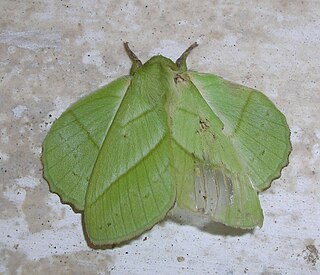
Gracillariidae is an important family of insects in the order Lepidoptera and the principal family of leaf miners that includes several economic, horticultural or recently invasive pest species such as the horse-chestnut leaf miner, Cameraria ohridella.

Pterolonchidae is a small family of very small moths in the superfamily Gelechioidea. There are species native to every continent except Australia and Antarctica.
Luceria is a genus of moths of the family Erebidae. It was described by Francis Walker in 1859. This genus is found in southern Asia, Australia, on several Pacific islands and a few species also in Africa.

Rivula is a genus of moths in the family Erebidae described by Achille Guenée in 1845.

Streblote is a genus of moths in the family Lasiocampidae. It was described by Jacob Hübner in 1820.

Trabala is a genus of moths in the family Lasiocampidae described by Francis Walker in 1856. The species are confined to China, throughout India, Sri Lanka, Myanmar and Java.

Eois is a genus of moths in the family Geometridae. The genus contains about 250 validly described species, most from the Neotropical region. Many species are still undescribed and the total number of species is estimated to be over a 1,000 in the Neotropical region alone. The genus was first described by Jacob Hübner in 1818.

Argyresthiidae is a family of moths known as the shiny head-standing moths. It was previously treated as a subfamily of Yponomeutidae.
Urodeta is a genus of moths of the family Elachistidae. The genus was originally assigned to the family Momphidae.
Pseudoradiarctia is a genus of moths in the family Erebidae from Afrotropics.
Epicampoptera is a genus of moths in the family Drepanidae. The genus was first described by Felix Bryk in 1913.
Automolis pallida is a moth of the family Erebidae. It was described by George Hampson in 1901. It is found in the Democratic Republic of the Congo, Eritrea, Ethiopia, Ghana, Kenya, Rwanda and South Africa.
Pseudoradiarctia affinis is a moth in the family Erebidae. It was described by Max Bartel in 1903. It is found in Ghana, Sierra Leone and Tanzania.
Pseudoradiarctia lentifasciata is a moth in the family Erebidae. It was described by George Hampson in 1916. It is found in South Africa, Zambia and Zimbabwe.
Pseudoradiarctia parva is a moth in the family Erebidae. It was described by Patrick G. Haynes in 2011. It is found in Tanzania and Zambia.
Pseudoradiarctia rhodesiana is a moth in the family Erebidae. It was described by George Hampson in 1900. It is found in Angola, the Democratic Republic of the Congo, Kenya, Malawi, Rwanda, South Africa, Tanzania, Uganda and Zimbabwe.
Pseudoradiarctia scita is a moth in the family Erebidae. It was described by Francis Walker in 1865. It is found in Cameroon, the Democratic Republic of the Congo, Ghana, Nigeria, South Africa, Tanzania, the Gambia, Uganda and Zambia.
Pseudoradiarctia tanzanica is a moth in the family Erebidae. It was described by Patrick G. Haynes in 2011. It is found in Tanzania.
Teracotona pallida is a moth in the family Erebidae. It was described by James John Joicey and George Talbot in 1924. It is found in Rwanda.
Ochromolopis pallida is a moth in the family Epermeniidae. It was described by Reinhard Gaedike in 2004. It is found on Madagascar.






